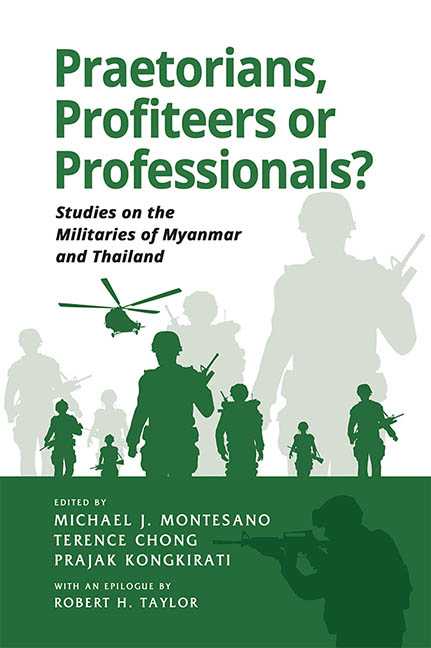Book contents
- Frontmatter
- Contents
- Acknowledgements
- About the Contributors
- 1 Introduction: Two Mainland Southeast Asian Militaries in Comparative Perspective
- 2 A New Tatmadaw with Old Characteristics
- 3 Thailand’s Military: Ideology and Sense of Mission
- 4 The Defence Expenditures and Commercial Interests of the Tatmadaw
- 5 The Economic Role of the Thai Military: A Commercial Logic to Coups?
- 6 Epilogue: Controlling or Playing Politics?
- Index
1 - Introduction: Two Mainland Southeast Asian Militaries in Comparative Perspective
Published online by Cambridge University Press: 09 October 2021
- Frontmatter
- Contents
- Acknowledgements
- About the Contributors
- 1 Introduction: Two Mainland Southeast Asian Militaries in Comparative Perspective
- 2 A New Tatmadaw with Old Characteristics
- 3 Thailand’s Military: Ideology and Sense of Mission
- 4 The Defence Expenditures and Commercial Interests of the Tatmadaw
- 5 The Economic Role of the Thai Military: A Commercial Logic to Coups?
- 6 Epilogue: Controlling or Playing Politics?
- Index
Summary
In 1959, Aguedo F. Agbayani of Pangasinan introduced to the Philippine Congress a bill “designed to prevent the growth of the power and influence of the military in this country, in order to spare our country from the tragic experiences of our Asian neighbors, recently in Burma and Thailand, where military dictatorship has marred their beautiful history” (Republic of the Philippines, House Bill 2220 [1959], quoted in Berlin 2008, p. 97).
Congressman Agbayani evidently had the keen sense of connections between the Philippines and the rest of Asia not uncommon among his countrymen in the post-war period. His reference to Burma, today's Myanmar, concerned the military's non-violent assumption of power in the country in October of the preceding year and to Chief of the General Staff Ne Win's consequent service as premier at the head of a “caretaker government” (Nakanishi 2013, pp. 84–88). In Thailand, Field Marshal Sarit Thanarat had staged coups d’état in September 1957 and again in October 1958 (Thak 2007, pp. 78–80). Of course, Agbayani could not know that, following elections in early 1960, Ne Win would return power to a civilian government in Rangoon, only to mount a coup of his own in March 1962 and thus to initiate long-term military control of Burma, or that military rule in Bangkok was destined to last another fourteen years, until October 1973. These developments and their legacies account for the publication of the present volume, treating the same two states whose examples troubled Aguedo Agbayani sixty years ago.
The late Donald Berlin called attention to the congressman's 1959 bill in his landmark study of civil-military relations in the Philippines during the decades preceding President Ferdinand E. Marcos's declaration of martial law in September 1972 (Berlin 2008). It was the contention of that study that—contrary to received wisdom, despite the absence of direct military control of the government in Manila, but very much as in other Southeast Asian states and societies—“military influence in Philippine state and society historically ha[d] been substantial” (Berlin 2008, p. 140). At the same time, the specific forms of that influence during the 1946–72 period proved varied.
- Type
- Chapter
- Information
- Praetorians, Profiteers or Professionals?Studies on the Militaries of Myanmar and Thailand, pp. 1 - 29Publisher: ISEAS–Yusof Ishak InstitutePrint publication year: 2020

